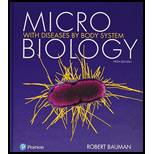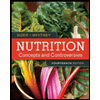
Microbiology with Diseases by Body System (5th Edition)
5th Edition
ISBN: 9780134477206
Author: Robert W. Bauman Ph.D.
Publisher: PEARSON
expand_more
expand_more
format_list_bulleted
Concept explainers
Question
Chapter 15, Problem 13MTF
Summary Introduction
Introduction:
The hypothalamus is a small portion of the brain. It is located just above the stem of the brain. It secretes substances that involve in the control of pituitary and other glands function. It plays an important role in the endocrine and nervous systems. It regulates the homeostatic process in the body.
Expert Solution & Answer
Want to see the full answer?
Check out a sample textbook solution
Students have asked these similar questions
Which evidence-based stress management techniques are most effective in reducing chronic stress and supporting college students’ academic success?
students in a science class investiged the conditions under which corn seeds would germinate most successfully. BAsed on the results which of these factors appears most important for successful corn seed germination.
I want to write the given physician orders in the kardex form
Chapter 15 Solutions
Microbiology with Diseases by Body System (5th Edition)
Ch. 15 - Prob. 1TMWCh. 15 - Some strains of Staphylococcus aureus produce...Ch. 15 - Evaluating an Abnormal CBC Roger Brown, an African...Ch. 15 - The Stealth Invader Tim is often seen walking...Ch. 15 - Prob. 3TMWCh. 15 - Phagocytes of the epidermis are called _________....Ch. 15 - Mucus-secreting membranes are found in ________....Ch. 15 - The complement system involves _________. a. the...Ch. 15 - The alternative complement activation pathway...Ch. 15 - Which of the complement fragments is inflammatory?...
Ch. 15 - The type of interferon present late in an...Ch. 15 - Interferons ________. a. do not protect the cell...Ch. 15 - Prob. 8MCCh. 15 - Toll-like receptors (TLRs) act to ________. a....Ch. 15 - Prob. 10MCCh. 15 - Modified True/False 1. _______ The surface cells...Ch. 15 - Modified True/False 2. _______ The surface cells...Ch. 15 - Prob. 3MTFCh. 15 - Prob. 4MTFCh. 15 - Prob. 5MTFCh. 15 - Prob. 6MTFCh. 15 - Prob. 7MTFCh. 15 - Prob. 8MTFCh. 15 - Prob. 9MTFCh. 15 - Prob. 10MTFCh. 15 - Prob. 11MTFCh. 15 - Prob. 12MTFCh. 15 - Prob. 13MTFCh. 15 - Modified True/False 14. ___________________...Ch. 15 - Modified True/False 15. __________________ NETs...Ch. 15 - Prob. 1MCh. 15 - Write the letter of the description that applies...Ch. 15 - Label the steps of phagocytosis.Ch. 15 - Prob. 2VICh. 15 - In order for a pathogen to cause disease, what...Ch. 15 - How does a phagocyte know it is in contact with a...Ch. 15 - Give three characteristics of the epidermis that...Ch. 15 - What is the role of Toll-like receptors in innate...Ch. 15 - Describe the classical complement cascade pathway...Ch. 15 - Prob. 6SACh. 15 - John received a chemical burn on his arm and was...Ch. 15 - What might happen to someone whose body did not...Ch. 15 - Prob. 3CTCh. 15 - Prob. 4CTCh. 15 - There are two kinds of agranulocytes in the...Ch. 15 - A patient has a genetic disorder that prevents him...Ch. 15 - Prob. 7CTCh. 15 - Scientists can raise germ-free animals in axenic...Ch. 15 - Prob. 9CTCh. 15 - Scientists are interested in developing...Ch. 15 - A medical laboratory scientist argues that...Ch. 15 - A patient has a genetic disorder that makes it...Ch. 15 - Prob. 13CTCh. 15 - Prob. 14CTCh. 15 - Using the following terms, fill in the following...
Knowledge Booster
Learn more about
Need a deep-dive on the concept behind this application? Look no further. Learn more about this topic, biology and related others by exploring similar questions and additional content below.Similar questions
- Amino Acid Coclow TABle 3' Gly Phe Leu (G) (F) (L) 3- Val (V) Arg (R) Ser (S) Ala (A) Lys (K) CAG G Glu Asp (E) (D) Ser (S) CCCAGUCAGUCAGUCAG 0204 C U A G C Asn (N) G 4 A AGU C GU (5) AC C UGA A G5 C CUGACUGACUGACUGAC Thr (T) Met (M) lle £€ (1) U 4 G Tyr Σε (Y) U Cys (C) C A G Trp (W) 3' U C A Leu בוט His Pro (P) ££ (H) Gin (Q) Arg 흐름 (R) (L) Start Stop 8. Transcription and Translation Practice: (Video 10-1 and 10-2) A. Below is the sense strand of a DNA gene. Using the sense strand, create the antisense DNA strand and label the 5' and 3' ends. B. Use the antisense strand that you create in part A as a template to create the mRNA transcript of the gene and label the 5' and 3' ends. C. Translate the mRNA you produced in part B into the polypeptide sequence making sure to follow all the rules of translation. 5'-AGCATGACTAATAGTTGTTGAGCTGTC-3' (sense strand) 4arrow_forwardWhat is the structure and function of Eukaryotic cells, including their organelles? How are Eukaryotic cells different than Prokaryotic cells, in terms of evolution which form of the cell might have came first? How do Eukaryotic cells become malignant (cancerous)?arrow_forwardWhat are the roles of DNA and proteins inside of the cell? What are the building blocks or molecular components of the DNA and proteins? How are proteins produced within the cell? What connection is there between DNA, proteins, and the cell cycle? What is the relationship between DNA, proteins, and Cancer?arrow_forward
- please fill in the empty sports, thank you!arrow_forwardIn one paragraph show how atoms and they're structure are related to the structure of dna and proteins. Talk about what atoms are. what they're made of, why chemical bonding is important to DNA?arrow_forwardWhat are the structure and properties of atoms and chemical bonds (especially how they relate to DNA and proteins).arrow_forward
- The Sentinel Cell: Nature’s Answer to Cancer?arrow_forwardMolecular Biology Question You are working to characterize a novel protein in mice. Analysis shows that high levels of the primary transcript that codes for this protein are found in tissue from the brain, muscle, liver, and pancreas. However, an antibody that recognizes the C-terminal portion of the protein indicates that the protein is present in brain, muscle, and liver, but not in the pancreas. What is the most likely explanation for this result?arrow_forwardMolecular Biology Explain/discuss how “slow stop” and “quick/fast stop” mutants wereused to identify different protein involved in DNA replication in E. coli.arrow_forward
arrow_back_ios
SEE MORE QUESTIONS
arrow_forward_ios
Recommended textbooks for you
 Fundamentals of Sectional Anatomy: An Imaging App...BiologyISBN:9781133960867Author:Denise L. LazoPublisher:Cengage Learning
Fundamentals of Sectional Anatomy: An Imaging App...BiologyISBN:9781133960867Author:Denise L. LazoPublisher:Cengage Learning Medical Terminology for Health Professions, Spira...Health & NutritionISBN:9781305634350Author:Ann Ehrlich, Carol L. Schroeder, Laura Ehrlich, Katrina A. SchroederPublisher:Cengage Learning
Medical Terminology for Health Professions, Spira...Health & NutritionISBN:9781305634350Author:Ann Ehrlich, Carol L. Schroeder, Laura Ehrlich, Katrina A. SchroederPublisher:Cengage Learning Nutrition: Concepts and Controversies - Standalo...Health & NutritionISBN:9781305627994Author:Frances Sizer, Ellie WhitneyPublisher:Brooks Cole
Nutrition: Concepts and Controversies - Standalo...Health & NutritionISBN:9781305627994Author:Frances Sizer, Ellie WhitneyPublisher:Brooks Cole


Fundamentals of Sectional Anatomy: An Imaging App...
Biology
ISBN:9781133960867
Author:Denise L. Lazo
Publisher:Cengage Learning


Medical Terminology for Health Professions, Spira...
Health & Nutrition
ISBN:9781305634350
Author:Ann Ehrlich, Carol L. Schroeder, Laura Ehrlich, Katrina A. Schroeder
Publisher:Cengage Learning


Nutrition: Concepts and Controversies - Standalo...
Health & Nutrition
ISBN:9781305627994
Author:Frances Sizer, Ellie Whitney
Publisher:Brooks Cole